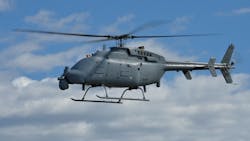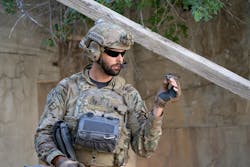United States Navy tests recon drone equipped with advanced radar systems
In this week’s roundup from the Association for Unmanned Vehicle Systems International, which highlights some of the latest news and headlines in unmanned vehicles and robotics, the U.S. Navy’s Fire Scout drone tests a new, improved radar system, the U.S. Army prepares to receive new shipments of miniature recon drones, and a new gimbal system for aerial vehicles has the potential for drone deployments.
U.S. Navy, Northrop Grumman begin flight testing MQ-8C Fire Scout equipped with AN/ZPY-8 radar
Northrop Grumman and the U.S. Navy recently began flight testing of the MQ-8C Fire Scout UAS equipped with the Leonardo AN/ZPY-8 radar.
The Fire Scout’s first flight with the radar took place on Feb. 27 at Webster Outlying Field. Before that flight, several weeks of ground tests were conducted. As the entities consider mission expansion opportunities for the UAS, testing will continue to progress.
“The AN/ZPY-8 radar significantly increases Fire Scout’s detection and tracking of targets. The ability to simultaneously employ multiple modes supports U.S. Navy intelligence, surveillance and reconnaissance requirements,” explains Melissa Packwood, program manager, tactical autonomous systems, Northrop Grumman.
“This increased capability enables Fire Scout to extend ranges to meet emerging requirements.”
Thus far, Northrop Grumman has delivered 32 of 38 MQ-8Cs to the Navy. All of the UAS will be equipped with the AN/ZPY-8 radar.
Having achieved initial operational capability in June 2019, the MQ-8C is scheduled for its first deployment next year.
FLIR Systems wins contract from U.S. Army to deliver its FLIR Black Hornet 3 PRS
FLIR Systems Inc. has won an additional $20.6 million contract from the U.S. Army to deliver its FLIR Black Hornet 3 Personal Reconnaissance Systems (PRS).
As part of the Army’s Soldier Borne Sensor (SBS) program, FLIR's advanced nano-UAS will support platoon- and small unit-level surveillance and reconnaissance capabilities.
“Black Hornet has proven to be a game-changing technology – a small package that can deliver a big edge on the battlefield,” says VP and General Manager of the Unmanned Systems & Integrated Solutions business line at FLIR, Roger Wells.
“We’re proud to continue supporting the U.S. Army’s Soldier Borne Sensor program. Enabling warfighters with a full-range of integrated unmanned solutions, both in the air and on the ground, is a strategic objective FLIR shares with the military.”
In Jan. 2019, FLIR was awarded an initial $39.7 million contract from the U.S. Army for its Black Hornet 3’s to support the SBS program. The company is currently delivering those systems for fielding across the force.
Described as extremely light and nearly silent, the combat-proven, pocket-sized Black Hornet PRS, which have a flight time up to 25 minutes, transmit live video and HD still images back to the operator.
Soldiers are provided with immediate covert situational awareness through the drone's information feed, which helps them perform missions more effectively. Thus far, FLIR has delivered more than 12,000 Black Hornet nano-UAS to defense and security forces across the world.
Deliveries will begin later on this year.
Trillium Engineering begins airborne testing new HD55 gimbaled camera system for UAS
Trillium Engineering has begun airborne testing of its new lightweight, high-definition HD55 system, which is designed for use on Group 2 and smaller Group 3 UAS.
In a gimbal just 5.5 inches in diameter and weighing 1750 grams, the HD55 system utilizes electro-optical (EO) and cryogenically cooled mid-wave infrared (MWIR) cameras, as well as an onboard image processor.
“At Trillium, we are constantly on the hunt for state-of-the-art technology, and the development of the HD55, the newest addition to our family of gimbaled systems, exemplifies this approach,” says Rob Gilchrist, cofounder and president of Trillium Engineering.
The HD55 replaces the end-of-life HD50. First delivered to customers in Nov. 2014, the HD50 came in four configurations. The HD50-MV was the smallest cooled MWIR gimbaled camera system on the market, Trillium notes.
The HD55 will have the same swept volume as its predecessor, but it will be slightly lighter and more capable than the HD50.
“The HD55 has a narrower field of view than the HD50, allowing the new system to get a closer, more actionable look at targets,” Gilchrist explains.
Trillium personnel have been flight testing the HD55 on a variety of airborne platforms, including a small multi-rotor drone and a manned Cessna aircraft, which serves as a surrogate for a fixed-wing tactical UAS. Company officials say that the next step is to begin testing on the real thing.
“We are already getting interest from major platform providers,” Gilchrist says.
Compiled by Brian Sprowl, Associate Editor, AUVSI
Share your vision-related news by contacting Dennis Scimeca, Associate Editor, Vision Systems Design
SUBSCRIBE TO OUR NEWSLETTERS

